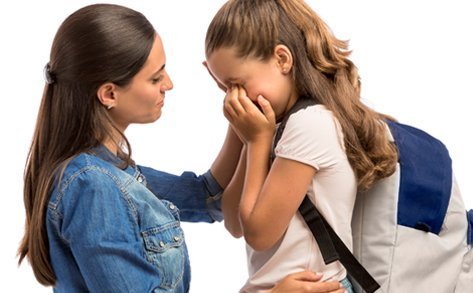 Separation anxiety disorder is characterized by age-inappropriate, excessive fear of being away from parents or home. Children with this disorder experience great distress when they separate or anticipate separating from loved ones or home. They continue to experience distress throughout the duration of the separation and may complain of physical symptoms, such as stomachaches or headaches. Children with separation anxiety disorder often refuse to attend school, sleepovers, or play-dates, unless their parents attend with them. If they do attend activities without their parents, they may frequently “check-in” with their parents via telephone calls or texts. When they are at home with their parents, they may follow their parents around the house, become upset when they are in a different room from their parents, and sleep near or with their parents. Often, children with separation anxiety disorder worry about something bad happening to them or their parents during separation, such that they would never see their loved ones again. Approximately 4% of children have separation anxiety disorder. The onset of this disorder typically occurs in early or middle childhood and is more common in girls than boys.
Separation anxiety disorder is characterized by age-inappropriate, excessive fear of being away from parents or home. Children with this disorder experience great distress when they separate or anticipate separating from loved ones or home. They continue to experience distress throughout the duration of the separation and may complain of physical symptoms, such as stomachaches or headaches. Children with separation anxiety disorder often refuse to attend school, sleepovers, or play-dates, unless their parents attend with them. If they do attend activities without their parents, they may frequently “check-in” with their parents via telephone calls or texts. When they are at home with their parents, they may follow their parents around the house, become upset when they are in a different room from their parents, and sleep near or with their parents. Often, children with separation anxiety disorder worry about something bad happening to them or their parents during separation, such that they would never see their loved ones again. Approximately 4% of children have separation anxiety disorder. The onset of this disorder typically occurs in early or middle childhood and is more common in girls than boys.
 Symptoms
Symptoms
 Red Flags
Red Flags Symptom Checker
Symptom Checker
 Online Tools For Parents
Online Tools For ParentsThe Child Anxiety Tales program is an online parent-training program designed to equip parents with skills and strategies they’ll need to help their children better manage anxiety.
The program is based on the latest evidence in the treatment of child anxiety and on cognitive -behavioral principals shown to be effective in helping anxious youth. Child Anxiety Tales is an interactive and engaging program that can be completed at your own pace from the privacy and convenience of your own computer. It is not a treatment but an online educational program for parents.
 Coping Cat Parents
Coping Cat ParentsCopingCatParents.com was developed to serve as a comprehensive and evidence-based resource on child and adolescent anxiety. Here you will get only information backed by research and tips and strategies that have evidence to support their use. We have brought together relevant resources, tools, and tips from the experts in the field that will be informative, and help you feel confident as you move forward in helping your child. Click on any of the links below to learn more: